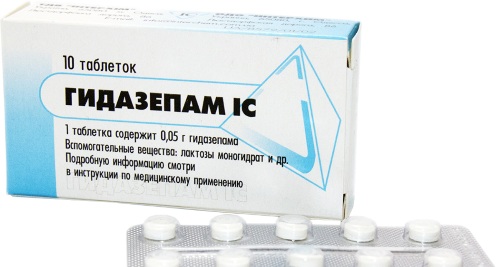Content
- Causes of vestibular neuronitis, etiology
- Symptoms and clinical manifestations
- Diagnostics and differential diagnosis
- Treatment
- Medication
- Gymnastics
- ethnoscience
- Consequences of the disease
- Forecast for vestibular neuronitis
- Video about vestibular neuronitis
Vestibular neuronitis is a neurological disorder that is associated with work of the vestibular apparatus and has similar symptoms with other diseases of the nervous system. Pathology does not pose a threat to the patient's life, however, it requires compulsory treatment.
Causes of vestibular neuronitis, etiology
The reasons for the development of the pathological process are not exactly known at the moment. However, it is assumed that the disorder develops against the background of damage to the 8th pair of cranial nerves. At the same time, the rest of the system remains completely healthy.
Today, there are several possible reasons for the development of a violation:
- viral damage to the vestibular system (especially herpes infection);
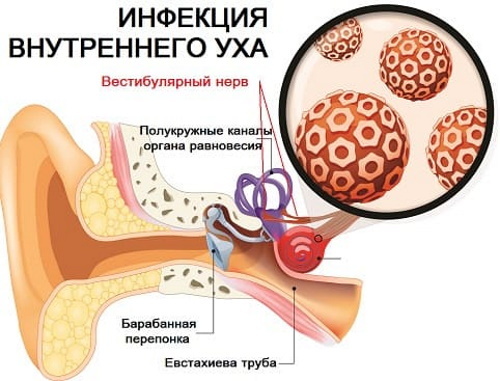
Vestibular neuronitis. Symptoms and treatment depend on the cause - intoxication of the body (food poisoning);
- diseases leading to metabolic disruptions;
- pathologies of an infectious or allergic nature of origin;
- hereditary factor.
The greatest importance is attached to viral etiology, since it was noted that the disease is often occurs during seasonal epidemics (ARVI, influenza) or as a result of already transferred viral infections.
Symptoms and clinical manifestations
Vestibular neuronitis (symptoms and treatment of the disease in each case are individual) is not always possible to determine appropriate signs, since in some cases the disorder is similar to other disorders of the vestibular system symptomatology.
The pathology is characterized by an acute and subacute course with a subsequent decrease in clinical manifestations, which persist for 7 days to 3 months. Then the violation completely disappears.
The risks of developing exacerbations are about 25%.
The development of pathology begins with severe attacks of dizziness, up to a complete loss of balance. This clinical picture persists for several days or several hours.
Vertigo is aggravated by any movement of the patient - rotation of the head or trunk. When you try to fix your gaze, the seizures gradually decrease.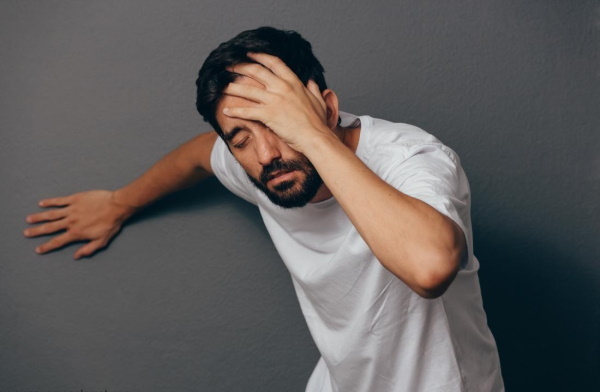
Other signs of the disease:
- nausea and vomiting;
- instability while walking, imbalance and coordination of movements;
- spontaneous twitching of the eyes (nystagmus) - it can be right or left, depending on the affected area of the nerve; the duration of the violation - from several days to 3 weeks;
- fatigue, weakness;
- blurred perception of surrounding objects (oscillopsia);
- instability in the Romberg position - an exercise that allows you to identify the presence of pathology, the patient will not be able to maintain the pose during illness.
It should be noted that with the development of the disease, the hearing organs remain absolutely healthy, since only the vestibular nerve, which is responsible for balance, is affected.
Stages of development of pathology:
- First stage. At this stage, the patient has pronounced symptoms with constant bouts of dizziness and vomiting. The duration of the first stage lasts for 5 days. The patient needs complete rest and rest.
- Second stage. Duration - 3 days. During this period, the patient is assigned various simple exercises to restore the functions of the vestibular apparatus.
-
Third stage. At this stage, the patient has noted the elimination of symptoms associated with involuntary eye movement. The patient is allowed to walk. With a good therapeutic effect, physical activity gradually increases.

Symptoms gradually decrease after 2-3 weeks. Dizziness attacks also become less pronounced and intense. If the pathology disappears within six months, then we are talking about an acute form of vestibular neuronitis. With a longer course of the disease, a diagnosis of a chronic form of the disorder is made.
Diagnostics and differential diagnosis
Vestibular neuronitis (symptoms and treatment in most patients are similar) is an independent disease, and it can be diagnosed by external signs.
First of all, the patient is examined. The specialist determines visual perception, evaluates the patient's coordination of movements. In this case, anamnesis is collected, the patient informs the doctor about the signs of a violation that he notes in himself.
In addition, videonystagmography is prescribed - testing that allows you to determine the degree of rotation of the eyeballs.
Also, if a pathology is suspected, Fuduko's tests are prescribed - marching, which allows you to determine the level of deviation of the patient from the normal position of the body in space.
To exclude other causes of the development of the disorder, such types of diagnostics as audiometry (examination of the hearing organs) and MRI of the brain are prescribed.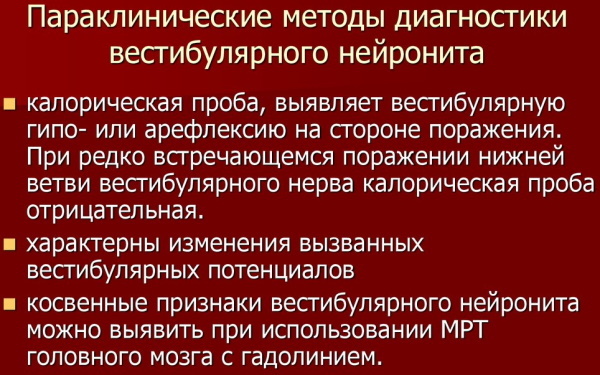
Differential diagnosis (MRI and audiometry) allows you to exclude other factors in the onset of pathology:
- Meniere's syndrome;
- the presence of neoplasms in the area of the cranial nerves;
- multiple sclerosis;
- stroke;
- labyrinthitis.
Additional examination methods are optional, but are recommended as a differential diagnosis.
Treatment
Treatment of the disease should be carried out in a comprehensive manner and includes taking medications and special exercises.
Medication
Vestibular neuronitis (symptoms and treatment of the disease can change as the patient recovers) in most cases, it is successfully eliminated with the help of various drugs.
First of all, drugs are prescribed that help eliminate symptoms - dizziness, nausea and vomiting.
| Group of funds | pharmachologic effect | Name of drugs |
| Vestibular suppressants | The mechanism of action of this group of agents is based on the suppression of the activity of H1-histamine receptors. In this case, the drugs have a pronounced antiemetic, sedative and antimuscarinic effect. They also help to reduce the activity of the vomiting center, as well as relax the smooth muscles in the digestive system and blood vessel walls. Indications: prevention and treatment of nausea and vomiting, dizziness of various origins. Dosages and other features of the application are determined by a specialist according to the prescribed drug. |
Daedalon, Dramina, Ciel |
| Histamine-like drugs | This group of drugs has a vasodilating and histamine-like effect, while improving microcirculation and permeability of the vessels located in the inner ear. The systematic use of medications leads to the elimination of dizziness, nausea, tinnitus, caused by disorders in the vestibular and cochlear apparatus. The drugs do not have a sedative effect and do not lead to the development of drowsiness. The treatment regimen depends on the specific agent and is developed by the treating specialist (otolaryngologist or neurologist). | Vestibo, Betagistin, Westinorm |
| Antiemetics | This group of drugs has a central action and blocks the activity of dopamine receptors. Prescribed funds for vomiting and nausea of various origins, as well as in the presence of various gastrointestinal disorders, accompanied by nausea and vomiting. When prescribing drugs, it should be borne in mind that their prolonged use can lead to various side effects. Dosing regimens are set individually, based on the selected drug and the severity of the pathological process. |
Cerucal, Sturgeon, Scopolamine |
| Sedatives | In most cases, tranquilizers (anxiolytics) are used, which have a sedative effect. These medicines contribute to the elimination of convulsive syndrome, have a nootropic and central muscle relaxant effect. They help to cope with various anxiety states, panic attacks, fears, without affecting the disorders caused by psychotic reasons. This group of drugs is part of the mandatory complex therapy and helps to cope with psychosomatic disorders that can occur with the development of vestibular neuronitis. |
Rudotel, Gidazepam, Sibazon |
| Diuretics | This group of drugs has pronounced diuretic properties and helps to eliminate excess sodium and chlorine from the body, while preventing the excretion of urea and potassium. Drugs can lower blood pressure. This effect manifests itself and persists for a short period of time. Drugs of this class are prescribed by a specialist, taking into account the patient's condition, since they can lead to the opposite effect with pathologies of the vestibular apparatus. |
Spironolactone, Furosemide, Lasix |
It is believed that antiviral drugs do not affect the course of the disease, and therefore, this group of drugs is rarely prescribed.
Medical treatment is carried out until the signs of nausea and vomiting are eliminated. With a decrease in the attacks of dizziness, they switch to other non-drug methods of therapy.
Gymnastics
Symptoms caused by the development of vestibular neuronitis can also be treated with various gymnastic complexes.
The essence of gymnastic exercises is to stimulate impulses emanating from various parts of the brain, which increases the threshold of excitability of the vestibular system.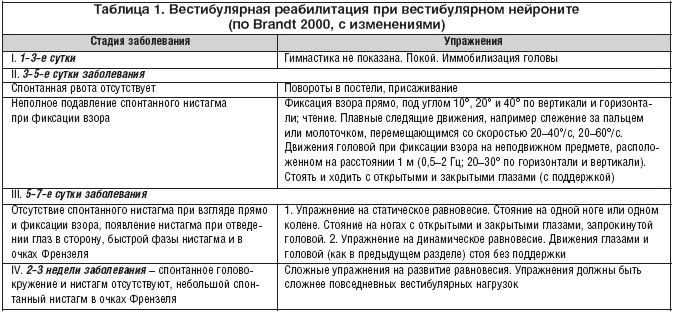
At the first stages of performing gymnastics, patients may experience various unpleasant symptoms that will go away on their own within a few days.
Exercises:
- In the early days of the disease, bed rest should be observed. Any exercise during this period of time is contraindicated.
- On the 3-5th day of illness, it is recommended to make smooth turns of the body in bed. They also perform exercises to fix the gaze at right or different angles, horizontally and vertically. Patients are advised to read books, newspapers or magazines for a short time.
- Finger tracking exercises. To do this, move your finger from one corner to another. In this case, the patient must carefully monitor the movements.
- The next exercise involves fixing your gaze on any stationary object located at a distance of 1 m (horizontally or vertically). In this case, the patient should rotate his head from side to side.
- Starting from the 5th day of illness, they switch to exercises to restore stability and improve coordination of movements. To do this, they stand straight on the runways of the legs and try to maintain their position as long as possible. The exercise is performed with both eyes open and closed.
- Standing on one leg or on one knee (you can alternate). When doing the exercise, you also need to try to keep the level position as long as possible.
- Stand on one leg with fixation of the gaze on an object or with rotation of the head. Do the exercise without any outside help or support.
Gymnastics for the eyes:
- Raise your eyes up, then down. You need to do the exercises at least 20 times, gradually increasing the pace.
- Move your gaze to the left, then to the right. The number of exercises is 20 times. The pace must be accelerated each time.
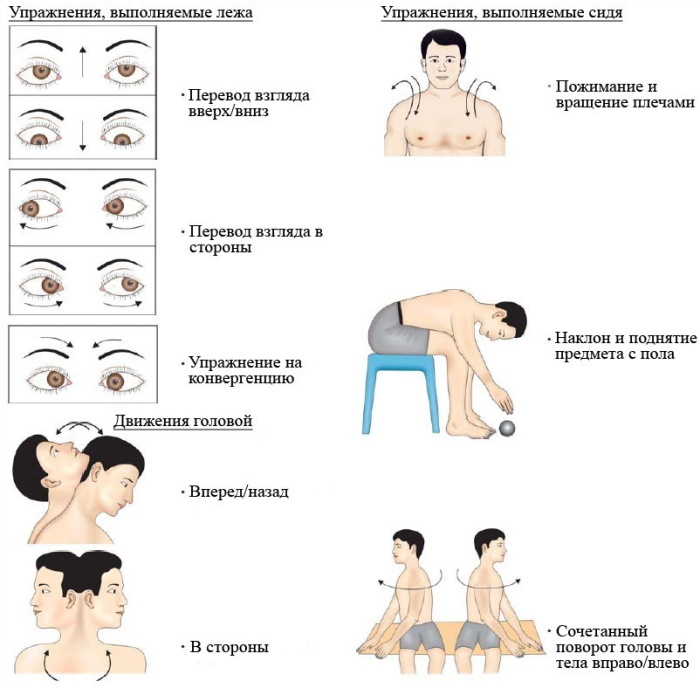
At the end of each turn of the eyes, it is recommended to fix your gaze on some stationary object for some time.
After a few weeks, they move on to more complex exercises, which should be prescribed by the attending physician in accordance with the indications and the severity of the pathological process.
ethnoscience
Vestibular neuronitis (symptoms and treatment of pathology should be systematically monitored by a specialist for determining the effectiveness of the prescribed therapy) can be successfully controlled with the help of folk remedies medicine.
Traditional methods of therapy of vestibular disorders must be previously agreed with a specialist. Such funds are used only as an additional or auxiliary treatment.
Recipes:
- Ginger drink. You need 30 g of ginger root. Pre-chop or grind the ginger to a powdery mass and mix it with 5 g of fennel, pumpkin seeds, celery, peppermint and orange zest. Transfer the mass to a container and pour 0.3 liters of boiling water. Let it brew for 30-40 minutes. They use ¼ st. daily. Before use, the infusion must be filtered.
- Treatment with oils. Take 1 tsp. essential oil of juniper and mix with 100 ml of castor oil and 20 ml of fir oil. Stir the resulting mass well and store in the refrigerator. At the first sign of dizziness, apply the product to the temples and massage in. Apply as needed.
- Medicinal infusion. Take 1 tsp. in equal parts flowers of hawthorn, meadowsweet and wild rose. Mix the ingredients and pour in 1 liter. boiled water. Leave the product to infuse. Take 100 ml daily 3 times a day. Strain the infusion before use. The duration of the course is 2 months.
-
Broth. Take 3 tbsp. chopped rhizomes of white peony, mix with the same number of linden flowers and 50 gr. peppermint. Transfer all components to a container and fill with boiling water. Close the container tightly with a lid and leave to infuse overnight. Drink 4 times per knock, 150 ml each. The broth should be filtered before use.
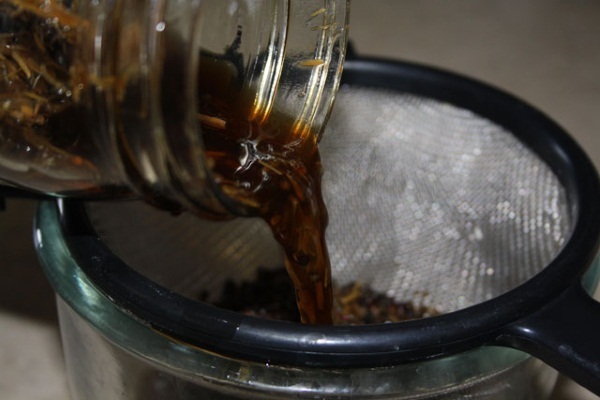
- Vinegar and honey drink. Boil 0.2 liters of water and add 20 ml of apple cider vinegar and 1 tsp. natural honey. Allow to cool. It is recommended to take the remedy in the morning on an empty stomach.
- Healing balm from 3 tinctures. Tincture number 1: grind 50 gr in a blender. dried clover flowers and pour in 0.5 liters of alcohol. Pour the resulting solution into a container, tighten the lid tightly and put in a cold place for 14 days. Tincture number 2: take 2 tablespoons. dry rhizomes of Dioscorea and chop finely. Pour the mixture with 0.5 liters of alcohol and put in a cold place for 2 weeks. Tincture number 3: take propolis, soften, move to a suitable container and pour 0.2 liters of vodka. Keep in a cool place for 10 days. After aging the funds, mix them together and take 30 drops 3 times a day daily.
Also, seaweed is an excellent remedy for vestibular disorders. They consume it in crushed form daily for 1 tsp. It is taken 2 times a day.
Before using one of the remedies, it is recommended to make sure that there are no allergies to them and familiarize yourself with the list of contraindications.
Consequences of the disease
Vestibular neuronitis (symptoms and treatment of the disorder can only be determined by the attending physician based on the visual inspection and various tests) does not pose a danger to human health and does not pose a threat to his life. The main complication that can arise in the absence of timely therapy is the exacerbation of pathology (relapse).
When relapses occur, the disease re-progresses with increased symptoms. In this case, damage to a healthy nerve also occurs.
This consequence is extremely rare and occurs in 2% of patients.
In 30% of cases, with complete clinical cure of the disease, the functions of the vestibular apparatus are partially restored. With the development of such a complication, additional diagnostic measures are carried out and appropriate treatment is prescribed.
As a preventive measure for the development of the disease, it is recommended to follow a diet, eat more fruits and vegetables. You should also pay attention to walking in the fresh air, airing the premises and sports.
Other recommendations:
- Timely treatment of various diseases, especially those of a viral or infectious nature of origin.
- Try to avoid injury and damage to the head area.
- Eat a variety of vitamins, minerals, macro- and microelements.
- Undergo systematic research (at least once a year).
- Give up bad habits - smoking, alcohol.
- Strengthening the immune system - hardening, exercise.
If these rules are observed, it is possible to avoid the development of a violation or prevent its recurrence.
Forecast for vestibular neuronitis
The prognosis for full recovery is favorable. Taking into account competent and timely treatment, complete clinical cure can be achieved in 30% of cases.
In the same number of patients, incomplete restoration of the functions of the vestibular apparatus was observed.
In 40% of all registered cases, the pathology acquired a chronic form, which required constant monitoring by the attending physician and the use of various maintenance therapy regimens.
If any symptoms of a disorder develop, it is recommended to immediately consult a doctor, since the prescribed treatment will help reduce the risk of complications and eliminate the likelihood of developing chronic vestibular neuronitis.
Video about vestibular neuronitis
Dizziness. Vestibular neuronitis:


